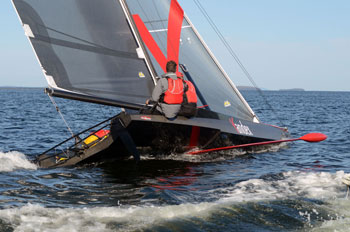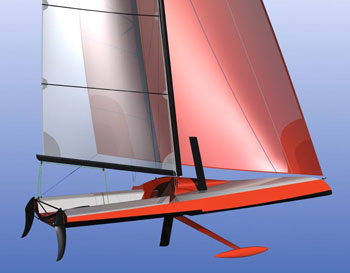Less is More
Speed Dream 27
1 of 4 articles on cutting edge naval architecture.

Speed Dream 27 launch day trial sail in Rockland Harbor October 2012. The all-carbon fiber vessel incorporates a range of experimental features designed to overcome the limitations of more conventional vessels. Brian Hancock Photo
After a few thousand years of boat design and building a lot of the options appear to have been fully developed and the limitations overcome. In automotive engineering it is the experimental work in Formula 1 cars that pushes the latest limits. Some of the automotive innovations for driving high speed and performance vehicles to the edge of catastrophe are eventually used to improve mass-market passenger vehicles.
There are sail and power monohull, catamaran, trimaran hulls of wood, fiberglass or steel. They come in all sizes and shapes with diminishing returns on added horsepower.
But at the experimental leading edge of the quest for more speed on the water the use of new materials, science and imagination is breaking through the performance barriers earlier designs have faced.
Speed Dream 27' is a sailboat designed by Vlad Murnikov. Murnikov wants to build the fastest offshore ocean racer on the planet. There are new sailing vessels that can reach high speeds in calm water but it is on the open ocean that Murnikov wants this vessel to perform.
Speed Dream is a combination of many high tech materials and design features. Murnikov said, “We designed Speed Dream in the virtual test tank of powerful computers and sophisticated software.” The performance characteristics of several vessels were studied and the best features from each were used. Monohulls, multihulls, wind surfers, submarines, hydrofoils, cigarette boats and planning hulls are among them.
Murnikov built his first boat 20 years ago in the then Soviet Union without government money. He said that that 25' boat was built in a 24' room of his 4th floor apartment. The parts were made, taken out a window and lowered to the ground where they were assembled. Since then the focus has been improvement. Speed Dream has unique features, which include three flat surfaces on the hull, two rudders, a canting keel with lead ballast, sharp reversed bow, and a lot of carbon fiber.
Speed Dream was built at Lyman-Morse Yachts in Thomaston, Maine. It was launched in Rockland, Maine in October of 2012. Everything about the boat says speed. It is the Formula 1 of sailing vessels. The tri-flat hull is designed for planning over the surface. Through sail adjustments the boat balances on one of it’s three hull surfaces minimizing wetted surface and drag.

Speed Dream 27 artist’s rendering. Lowered black dagger board left center, raised black dagger board right center, red weighted ballast keel in raised position center, reversed bow contour.
To get high speed out of a catamaran it needs to be heeled over on one of the hulls thereby lifting the other out of the water making it a flying ballast hull. Speed Dream’s long canting ballast lead keel pivots on the centerline of the hull and can swing up 80+ degrees and out of the water to windward. Heeled over it rides on one narrow flat bottom section while the other is out of the water.
The hull doesn’t ride up and over waves or plow through them. The sharp bow slices through waves avoiding the pounding characteristic of two of its antecedents - the wind surfer and the cigarette boat. Speed Dream’s bow is inverted, curving up and aft from the waterline. This facilitates piercing waves and shedding the water.
Designing a fast monohull vessel for use offshore is an entirely different proposition from designing a mono or multihull for calm waters. The ocean surface is very complex. Powerful computers and software were required to simulate this surface for virtual tank testing. ‘Tyler Doyle at Doyle Sails did the computations. He has a very sophisticated understanding of the technology,” said Murnikov. It is also expensive. Yandex, a Russian search engine company, has financed the project.
Speed Dream is a prototype for larger vessels. The next project is a 50' model. Ultimately Murnikov wants to build a 100' version for offshore racing. He said he is not interested in the America’s cup, but in high-speed circumnavigation of the globe.
The Jules Vern Trophy for sailing around the world in 80 days has gone to a French Trimarran for a 45-day circumnavigation. Murnikov said he is not interested in knots per hour, but in miles per day of sailing, hundreds of miles per day.
Performance, economy, braking systems, steering, safety and durability are a few of the ways modern cars are made better through Formula 1 experimentation.
Murnikov said he is out to revolutionize sailing. There are Speed Dream features that are changing sailing already. Murnikov envisions changes that will effect commercial vessels from small fishing boats to large cargo ships in the near future. It’s not likely that there will ever be a Speed Dream with a hauler doing 50 knots between traps in the Gulf of Maine. But some feature or features could trigger the next Will Frost’s imagination to make the leap to another generation of vessel as different as the lobster sloop is from a 38' Calvin Beal.
